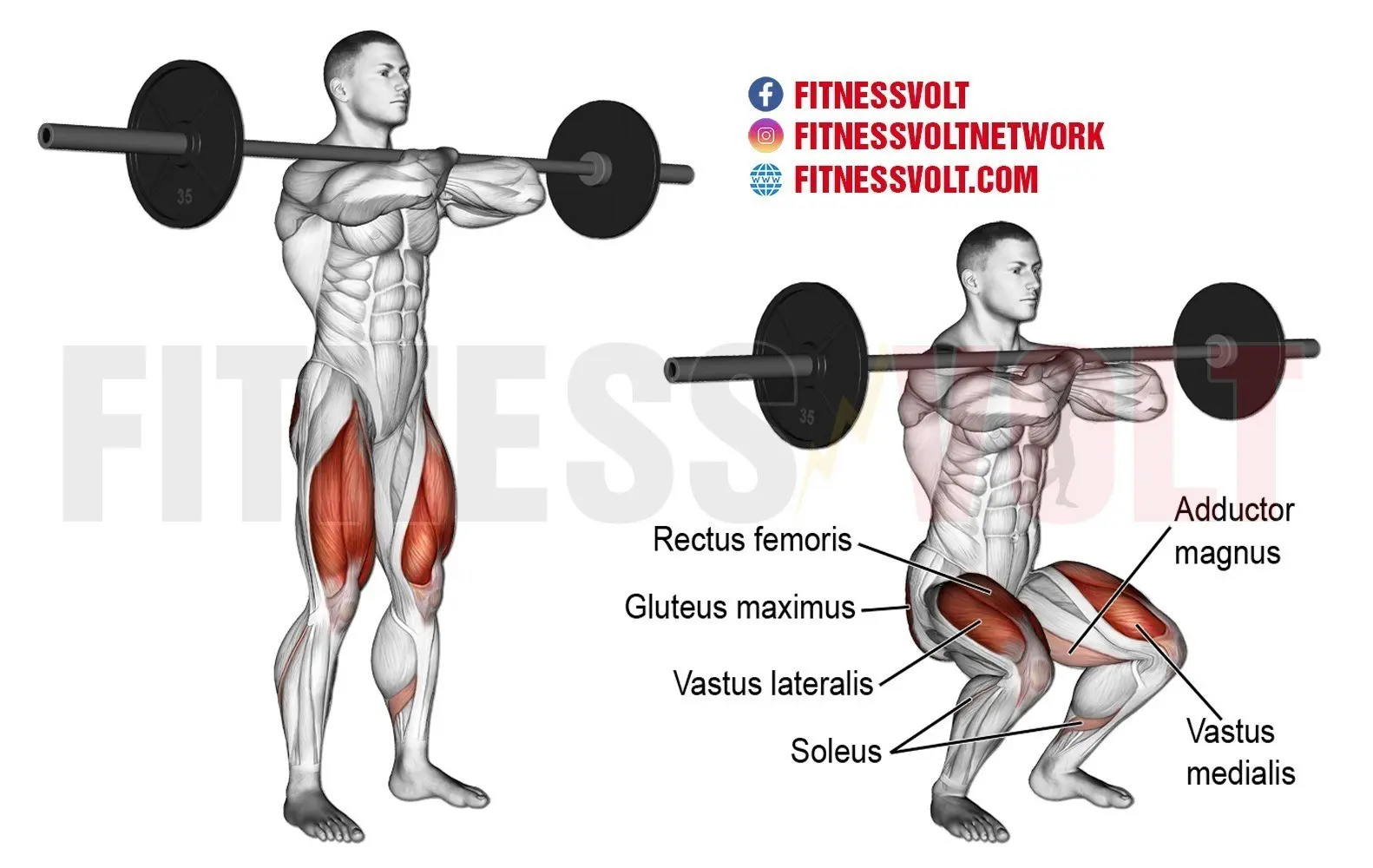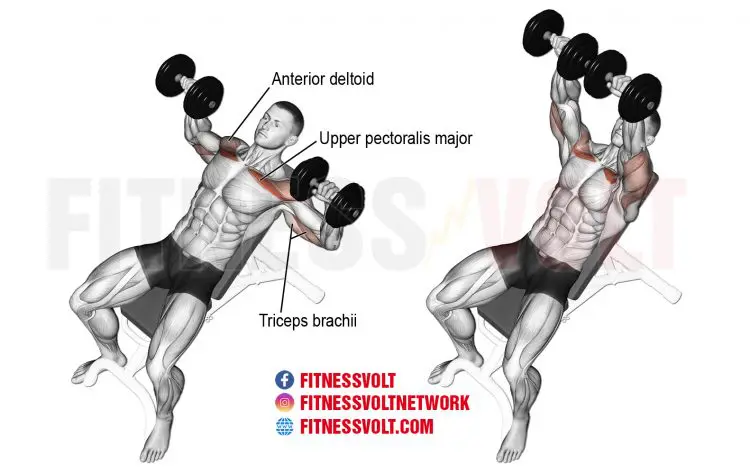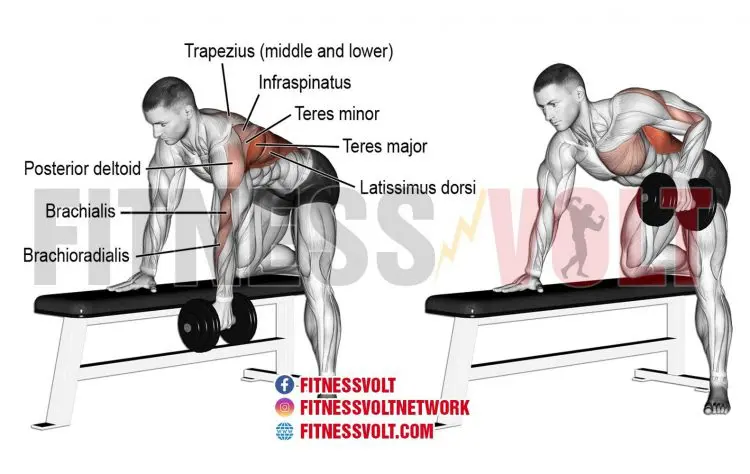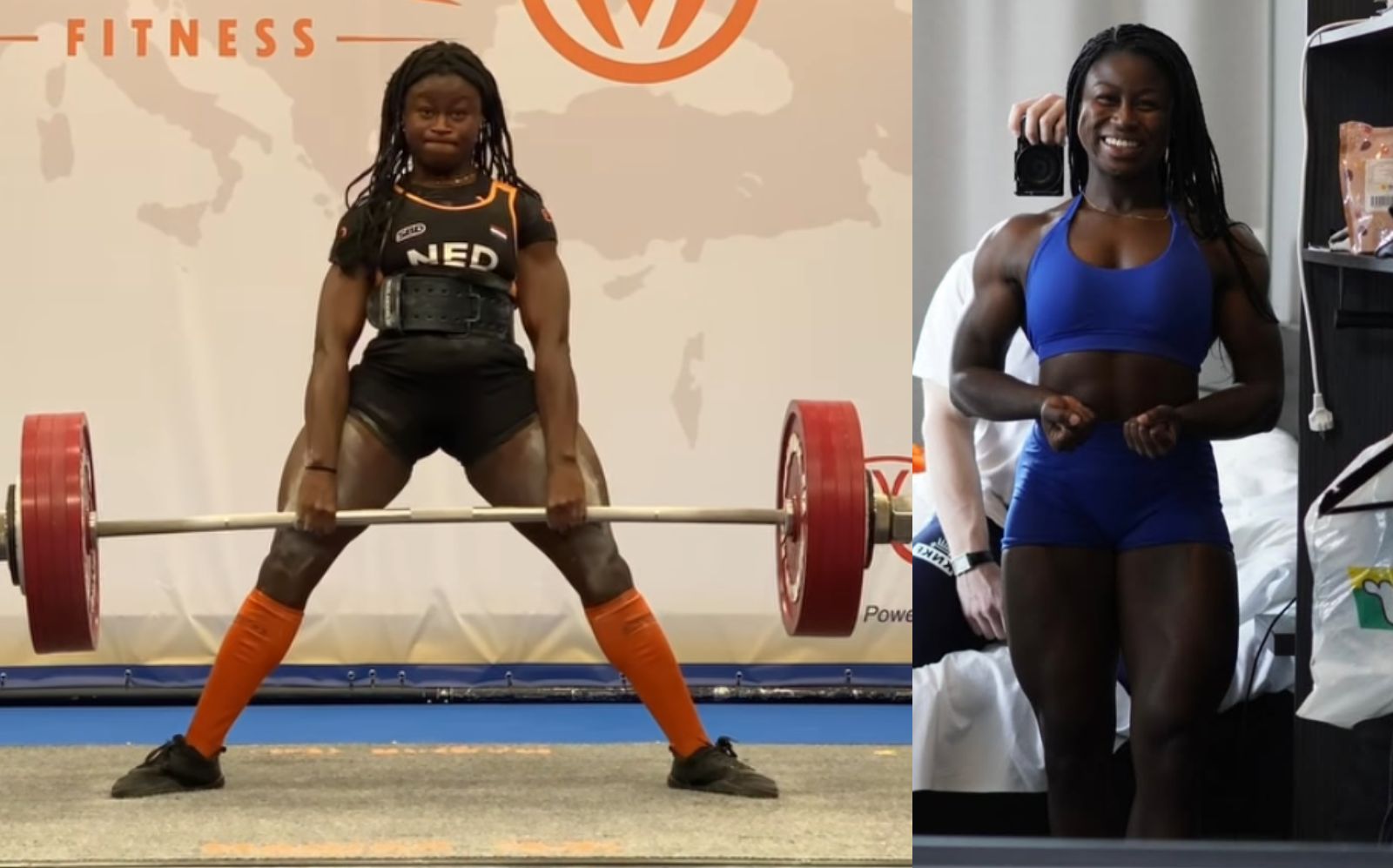After several months of having to resort to home workouts (nothing wrong with that), many gyms have reopened. This means you’ll be needing a good muscle, strength, and power-building routine if you don’t already have one. But even if you do, we put together a 4-day split workout that we recommend you try.
You have to earn your results which is only possible when the effort is sufficient both in and out of the gym. We took care of the planning for the training aspect and now, all you have to do is execute. So, with that being said, here’s an in-house workout strategically designed to get you results…
4-Day Split Workout Details
Before we get into the routine, let’s discuss a few things to ensure you understand the plan and strategy.
- We recommend that you follow this plan for 10 weeks or 2.5 months to experience good results.
- The program consists of two strength/power-focused sessions and two hypertrophy-focused sessions each week.
- Each major muscle group will get trained twice per week.
- Add in core and direct arm training where you find fitting.
- We’ve split and paired up certain body parts to ensure you can complete each session.
- Use a weight that challenges you during each set. For strength and power days, stop 1-2 reps short of failure. For hypertrophy days, try to reach failure and go a few reps beyond if possible. Although, it’s not always necessary to go to failure for hypertrophy-focused sets.
- For strength and power days, you can take longer rest periods in between sets although we recommend anywhere from 2-5 minutes depending on the exercise. For hypertrophy days, choose an adequate rest time between 30 seconds to 1 minute, 30 seconds depending on the difficulty of the exercise.
- Allow for a minimum of three days and a maximum of four in between sessions to allow for optimal recovery.
- We’ve included links to exercise instructions in the text while we’ve provided exercise instructions for others.
Before you do any of these workouts, do at least 5-10 minutes of light cardio activity. This helps to warm up your joints, reduce injury, and it also results in better performance right out of the gates. You can also follow this up with a few minutes of dynamic stretching.
Now it’s time to get training!
Workout 1 – Lower-Body Strength/Power
Again, make sure to stop a rep or two short of failure unless noted otherwise, as the following exercises will be taxing due to the heavier loads and lower rep ranges.
Level Up Your Fitness: Join our 💪 strong community in Fitness Volt Newsletter. Get daily inspiration, expert-backed workouts, nutrition tips, the latest in strength sports, and the support you need to reach your goals. Subscribe for free!
| Lower-Body Strength/Power | ||
| Exercise | Sets | Reps |
| Barbell deadlift | 3 | 8, 6, 4 |
| Barbell hip thrust | 3 | 10, 7, 5 |
| Dumbbell reverse lunge w/ step-up jump | 3 | 6 to 8 reps each leg |
| Bodyweight hip abduction | 2 | max |
Barbell deadlift – 3 sets x 8, 6, 4 reps
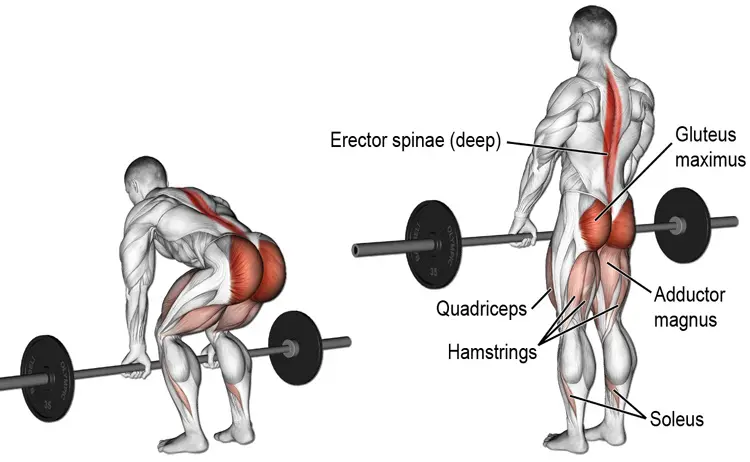
We chose the barbell deadlift for the first exercise in this strength/power-focused workout because it’s the standard by which brute strength is usually measured. Now, the deadlift does work all muscles of the body but there’s just no getting around that.
But we’ll utilize it for lower-body development and therefore, it’s best to do it first when you’re fresh and fully charged.
Barbell hip thrust – 3 sets x 10, 7, 5 reps
If you want massive glutes and equally impressive hamstrings, well, any compound lower-body exercise can do the job. However, the barbell hip thrust is sort of like an isolation/compound exercise combination that allows you to hammer these posterior chain (backside of the body) muscles for growth, strength, and power.
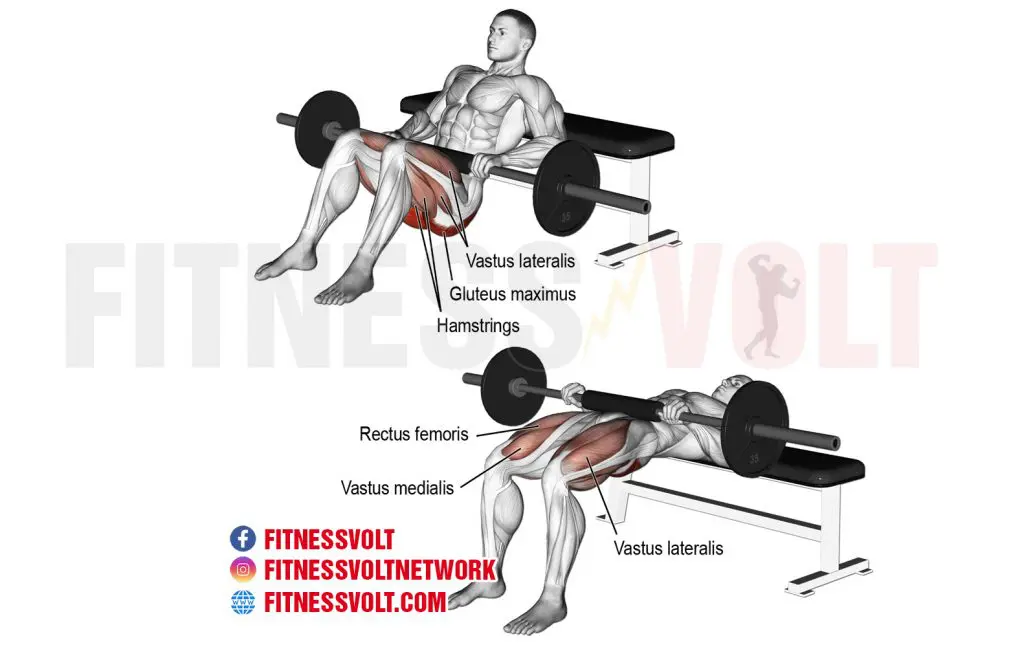
But that’s not all, research shows that the hip thrust engages the hip extensor muscles (gluteus maximus/butt and biceps femoris/hamstring muscle) to a larger extent compared to more conventional exercises such as the squat. Consequently, the barbell hip thrust was shown to improve sprint times when training with submaximal loads.
So, if you’re an athlete, then this is a must-have movement in your training regime… (1)
Bret Contreras (The Glute Guy), Ph.D., CSCS, participated in a study with the help of several others to compare the effects of a six-week hip thrust vs. front squat resistance training program on performance in adolescent males. (2)
Based on the findings, it was concluded that the hip thrust could be superior to the squat and deadlift for activating the hip extension muscles and less of the other, surrounding muscles. This makes sense as the bar sits on the hip crease and not on the spine. As a result, the hips are under a constant load. But during the squat, the quads and hamstrings have to help more with knee and hip extension due to the more upright position. (3)
So, the extensors tend to take the brunt of the load whereas the hamstrings, abductors, and quadriceps are less involved.
According to the study, “The barbell hip thrust may be an effective exercise for increasing horizontal force production and may thereby enhance performance in athletic movements requiring a horizontal force vector, such as horizontal jumping and sprint running”.
This is solid information on the benefits of the hip thrust when compared to other common lower-body exercises.
Dumbbell reverse lunge w/ step-up jump – 3 sets x 6-8 reps each leg
This movement is a two-in-one that’ll help to develop unilateral strength/power while simultaneously eliciting a hypertrophy response. Unilateral training allows you to focus on training one side at a time as opposed to both (bilateral training).
For example, the barbell deadlift and hip thrust are bilateral movements because each rep involves both sides at the same time. The lunge and step-up are unilateral since one side is working separately from the other under a specific load.
The benefits of utilizing unilateral exercises include identifying and correcting strength and muscle imbalances in addition to improving athletic performance, explosiveness, balance, core stability. Unilateral exercises also prevent injuries and are very beneficial for rehabilitation purposes.
Although, for the purpose of this article, we’ll focus on more of the aesthetic and functional benefits.
To do it:
- Stand in front of a box, bench, or a solid object of a similar height or even higher if you desire.
- Perform a reverse lunge with the left leg back and right leg in front.
- Push through the right leg to stand up and then step up onto the object with the left leg and explosively jump up and land back on the platform with your left foot.
- Step down with the right leg first and then bring the left leg back into the bottom of the lunge which is the same as the starting position or step 1.
- After you complete the desired number of reps, the left leg will be in front during the lunge and you’ll perform the jumps using your right leg.
Note: The video does not show this exercise being performed using dumbbells but to develop strength and power, we recommend you grab a pair of dumbbells that’ll allow you to achieve the desired reps.
Bodyweight hip adduction – 2 sets to failure
Adduction of the legs means moving them toward from the midline of the body. And it’s the same thing… if these muscles are weak, the hips and knees are thrown out of balance which isn’t a good thing. The bodyweight hip adduction should help prevent these issues.
Workout 2 – Upper-Body Strength/Power
| Upper-Body Strength/Power | ||
| Exercise | Sets | Reps |
| Barbell bench press | 3 | 4 to 5 |
| Standing jammer/landmine press | 3 | 6 to 8 |
| Standing cable crossover | 3 | 6 to 8 |
| Depth plyo push-ups | 2 | max |
| Straight-arm pushdown | 1 | 10 to 12 |
| Pendlay row | 3 | 10 to 12 |
| Wide-grip weighted pull-up | 2 | max |
| Seated close-grip cable row | 3 | 6 to 8 |
| Smith machine shrugs | 2 | 8 to 10 |
| Face pulls | 2 | 10 to 12 |
Barbell bench press – 3 sets x 4-5 reps
To start off the upper body strength-power session, there’d be nothing else as fitting as the basic barbell bench press. You can overload the pecs using this exercise more than most and it’s just a must-have strength and mass developer.
Standing jammer/landmine press – 3 sets x 6-8 reps
The jammer press trains explosive upper-body pushing power and is an underrated exercise. You’ll emphasize the upper pec muscles in addition to working the deltoids, triceps, core, back, legs… it’s just an overall functional movement.
You don’t just want to look good as a result of your training but you want to be powerful and this is a very effective way to accomplish this.
You can either use a machine or landmine set up to do these. Although, the latter is probably easier to get access too.
To do it:
- Grip the end of the barbell with one or two hands, or the handles if using a machine. Hold the barbell near your upper chest.
- Keep your feet about shoulder-width apart, body neutral, and maintain a tight core.
- Squat down enough to generate power and explode through the legs, then press the weight away from you.
- Lower the weight back down and repeat then switch sides if you’re not using both arms.
Standing cable crossover – 2 sets x 6-8 reps
Although this movement isn’t necessarily thought of as a strength or power exercise, it’s still important. It’s imperative to get stronger while performing exercises that involve the adduction (bringing the arms across the midline of the body) and abduction of the arms to maximize the strength and stimulation of the muscle fibers.
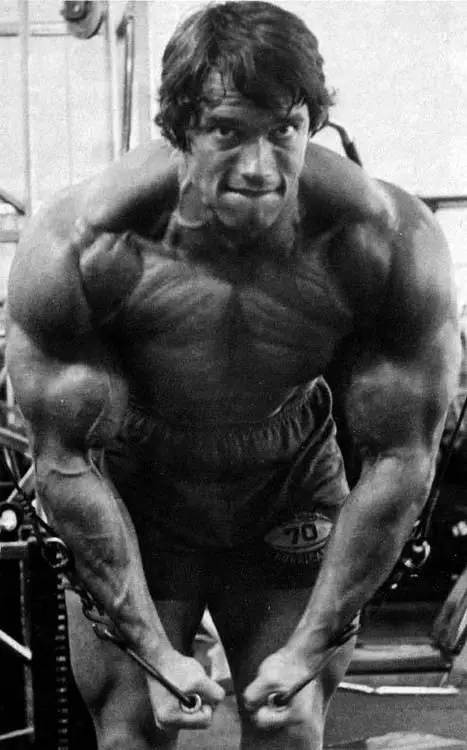
The standing cable crossover not only allows you to do this, but it’s done standing which places you in an athletic/functional body position. And if you think about it, we can benefit from improving strength in a position where the arms are far away from the center of the body. For example, you might have to overcome an opposing force (e.g. opponent) or change direction quickly and that strength is needed to pull our arms back in toward the center.
To do it:
- Attach two single-grip handles to about lower chest level on both sides of the cable system.
- Grip both handles and walk forward in the center until you create tension while the arms are positioned behind you. Use a split or hip-width stance.
- Bend your elbows slightly and keep your grip neutral.
- Contract your chest then move both arms toward each other and cross them for a more pronounced contraction.
- Bring your arms back to the start until you feel a decent stretch in the pecs and repeat. But this time, cross your arms opposite of what you did the first time (e.g. instead of the left arm crossing over the right arm, cross right arm over the left arm) and alternate for the set.
Depth plyo push-ups – 2 sets/stop a few reps short of failure
We’ll finish off with some depth plyo push-ups since we already addressed the strength component of this workout. The jammer press also helps with power but it was done using resistance. You can do these plyo push-ups essentially anywhere to learn how to generate power and it’s a great finisher.
Check out the video below to see how it’s done…
Straight-arm pushdown – 1 set x 10-12 reps
Optimal scapular and shoulder blade strength and stability are so crucial for movements such as deadlifts, squats, bench press, shoulder press, pull-ups… and the list could go on really. It’s an underrated component of assistance training but can do so much for your progress.
Now, sure, deadlifts and other back exercises help to strengthen this area. But there’s nothing like doing some isolation work to train the upper back muscles to maintain the necessary position to be able to train with heavy loads safely and effectively.
Do this exercise first to reinforce that position that you want to carry over into the following exercises.
To do it:
- Attach a straight bar to the high point on the cable pulley machine.
- Grip the bar about shoulder-width apart, keep your chest up, and lean just slightly forward. Your arms should be extended.
- Flex your lats, pull your shoulders down and drive your elbows back until the bar reaches your body.
- Slowly return your arms to the starting position so that your hands stop at about chin level. Do not shrug your shoulders up at the top of the movement and keep everything tight.
Pendlay row – 3 sets x 10-12 reps
The Pendlay row allows us to maximize concentric strength and power. It’s a bent-over row with a dead stop for about 1 second, followed by an explosive row. There’s no momentum to help you involve the assisting muscles to the same extent.
Your lower back will also get stronger by incorporating movements such as this one due to the bent-over position and the core muscles will also benefit greatly.
Wide-grip weighted pull-up – 2 sets to failure
Pull-ups should always be incorporated for back training. But many times, our body weight isn’t enough, and therefore, using a dumbbell or weight belt can allow us to hit failure earlier. This is better for building more strength. Not to mention, using a wide grip for the pull-up actually engages the teres major muscle which starts at the armpit and ends near the top of the upper arm bone (humerus).
This muscle is a medial rotator that helps the lats to move the humerus back and down when extended. In addition, it helps to stabilize the upper part of the humerus.
Level Up Your Fitness: Join our 💪 strong community in Fitness Volt Newsletter. Get daily inspiration, expert-backed workouts, nutrition tips, the latest in strength sports, and the support you need to reach your goals. Subscribe for free!
To do it:
- Attach the weight belt or place a dumbbell between your feet.
- Jump up and grab the bars wide.
- Flex your lats and pull your shoulders down so that your head is not sinking down into them.
- Pull yourself straight up to the bar by pulling your elbows down and not back.
- Lower yourself back down and repeat.
Seated close-grip cable row – 3 sets x 6-8 reps
The seated row is a great exercise for building the back muscles overall. And by using a close grip, you really maximize the attention on the lats, erector spinae, and middle trapezius muscles. And actually, a study that compared muscle activation between back exercises found that the seated row was pretty effective for stimulating these exact muscles compared to other back muscles. (4)
Smith machine shrugs – 2 sets x 8-10 reps
The Smith machine is often bad-talked because it’s not a free weight option. Well, free weights aren’t always better than machines or workout equipment that locks you in place during an exercise. The Smith machine shrug can actually take a lot of stress off of your lower back while allowing you to lift pretty heavy.
That’s because there isn’t as much stabilization required compared to a free weight barbell shrug which allows you to focus on doing your reps.
Face pulls – 2 sets x 10-12 reps
We highly recommend adding face pulls at the end of your upper body sessions simply because it’s good for your posture and strengthening the upper posterior muscles. It’s honestly hard to do enough work for the upper back muscles and for many people, it’s still a weak area even with a decent amount of back training.
Make every single rep count and avoid using any momentum.
Workout 3 – Lower-Body Hypertrophy
Now it’s time to focus on building some muscle and the following exercises/workouts are perfect for this purpose.
| Lower-Body Hypertrophy | ||
| Exercise | Sets | Reps |
| Barbell front or back squat | 3 | 6RM, 12RM, 15RM |
| Dumbbell Bulgarian split squat | 2 | 10 to 12 |
| Romanian Deadlift | 2 | 8 to 12 |
| Kettlebell swing | 2 | 10 to 15 |
| Walking lunges | 1 | 20 |
Barbell front or back squat – 3 sets x 6RM, 12RM, 15RM
It really doesn’t matter whether you opt for the front or back squat. In fact, research shows that both elicit the same degree of muscle activation. Although, the front squat may be superior for the safety of the joints over the long haul. (5)
But if you’re doing the back squat properly and interchange it every now and then, you really shouldn’t have an issue. Now do keep in mind, the front squat can take a little getting used too. It could even be dangerous if you try to use too much weight at first.
So, start off to where you can comfortably maintain an upright posture for your safety and then gradually add weight to the bar.
It’s just important that you get good depth with either squat variation to maximize the recruitment of all lower-body muscles.
Dumbbell Bulgarian split squat – 2 sets x 10-12 reps
We don’t like to leave out the Bulgarian split squat when it comes to designing any lower-body hypertrophy workout. It’s a superior leg-building movement that offers the unilateral benefits that we talked about earlier. Plus, you can load it pretty heavily and safely reap the benefits.
Romanian Deadlift – 2 sets x 8-12 reps
The Romanian deadlift is a more functional exercise for training the hamstrings because you develop and improve joint stability, and the fact that it’s a closed kinetic chain exercise means it has better strength and performance carryover.
Kettlebell swing – 2 sets x 12-15 reps
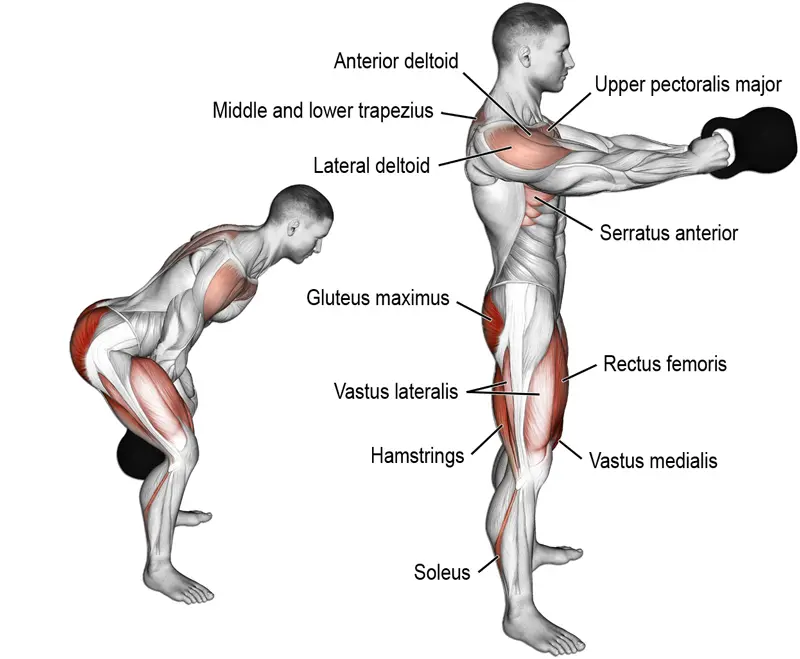
The kettlebell swing is a phenomenal exercise for a few reasons. The first being that it’s an explosive triple extension exercise that has huge carry over into athletic performance due to the power and explosiveness involved. Now by triple extension, we mean the ankles, knees, and hips go into full extension which is how the body generates that maximum strength and power.
Secondly, the kettlebell swing was shown in an ACE-sponsored study to activate the short head of the hamstrings (biceps femoris) even better than the leg curl. Why is this important? Well, the biceps femoris only crosses the knee joint while the other two muscles (semitendinosus and semimembranosus) cross both the hip and knee joints.
Therefore, you have to include an exercise that really involves this muscle through knee flexion in order to maximize its development.
Walking lunges – 1 set x 20 reps total
We’ll finish off with a set of walking lunges and you can either do these with light dumbbells, a light barbell or just using your own bodyweight.
Workout 4 – Upper-Body Hypertrophy
| Upper-Body Hypertrophy | ||
| Exercise | Sets | Reps |
| Incline dumbbell press superset | 3 | 10 to 12 |
| Weighted chest dips superset | 3 | 10 to 12 |
| Single-arm dumbbell bent-over rows | 3 | 8 to 10 |
| Bodyweight chin-ups | 3 | max |
| Weighted back extensions superset | 2 | 10 to 12 |
| Dumbbell shrugs | 2 | drop set |
| Face pulls | 2 | 15 |
| Dumbbell shoulder press | 2 | 8 to 10 |
| Cable rear delt row | 2 | 8 to 10 |
Incline dumbbell press superset w/ low cable fly – 3 sets x 10-12 reps each exercise
The incline dumbbell press emphasizes the upper chest area near the clavicle. Then we superset this exercise with the low cable fly for additional stimulus and focus on the upper chest fibers. The fly allows us to adduct the arm strategically in the direction of the upper fibers for optimal stimulation.
But why we chose the fly is because you’re able to adduct the arms beyond the midline of the body to allow for an even better and more effective contraction of the chest muscles. This isn’t possible with basic chest exercises and so you can see the value here with this exercise.
To do the fly:
- Attach two single-grip handles to the low notches of the machine.
- Grip the handles and walk out far enough to create tension with your arms behind your body. Stand with one foot in front of the other for stability.
- Bend your elbows slightly and then squeeze your pecs as you move your arms up and across the midline of your body of which you’ll have to cross both arms to accomplish this. Your hands should end up level with your opposite shoulder.
- Bring your arms back down slowly until you feel a decent stretch in the pecs (don’t overdo it) and then repeat. Alternate crossing one arm over the other for sets.
Weighted chest dips superset w/ high cable fly – 3 sets x 10-12 reps each exercise
The chest dip is an effective movement for hitting the abdominal (lower) head of the pecs. This is possible because of the arm position below the pecs which allows us to follow the downward fiber direction. Then it’s the same concept here with the high cable fly. We’re able to get full adduction of the arms to further stimulate the muscles.
But back to the dip, use a little extra weight that’ll allow you to come close to or reach failure a bit quicker. You can achieve this by using a belt or by holding a dumbbell between your feet.
To do the weighted chest dip:
- With the weighted belt on or dumbbell in between your feet, grip the handles and support your body weight using your arms.
- Depress your shoulders (move them down) to prevent your head from sinking down into them.
- Stick your chest out while keeping your arms and shoulders back.
- Lean forward and lower yourself until your arms are at a 90-degree angle while still keeping your shoulders depressed.
- Contract your chest while pushing yourself back up to the top and repeat.
To do the high cable fly:
- Attach two single-grip handles to the high notches on the cable machine.
- Grip both handles and stand in the center but don’t walk forward.
- Bend your elbows slightly and squeeze your pecs while moving your arms down below your waist and cross them for a more pronounced contraction.
- Return your arms back up until you feel a good stretch and then repeat while alternating arms during the contraction portion of the movement.
Push-ups – 2 sets to failure
At this point, you should be pretty exhausted and even a basic bodyweight push-up should be challenging. The push-up is a great way to work the chest overall.
Single-arm dumbbell bent-over rows – 3 sets x 8-10 reps
For back, we’ll start off with single-arm dumbbell rows. Besides the unilateral benefits, we can get a larger range of motion and contraction of the lats and surrounding muscles of the back.
Bodyweight chin-ups – 3 sets x failure
The chin-up allows us to get a very good stretch in the lats due to the arms being positioned in front of us. In addition, it works pretty much all back muscles plus the biceps and forearms.
To do it:
- Grab the bar using an underhand, shoulder-width grip with your feet together and held just in front of your body.
- Depress your shoulders so that your head doesn’t sink down into them.
- Pull yourself up by driving the elbows and contract the lats.
- Slowly lower yourself back down and repeat.
Weighted back extensions superset w/ straight-arm pushdowns – 2 sets x 10-12 reps each exercise
We have to work the lower back now and the back extension is a good exercise for accomplishing this. Now, if you don’t feel comfortable with the back extension stand, then use a machine instead. We’ll combine this with the straight-arm pushdown to again, train the scapular and shoulder blade strength for the bigger back exercises.
Dumbbell shrugs – 2 drop sets
The dumbbell shrug will hammer your traps to get them looking like mountains. We’ll do two drop sets here.
So first, use a relatively heavy weight that allows you to complete 5-6 challenging reps. Then, drop the weight by 5 pounds (each hand) and continue to rep out until you reach failure or near it. Continue this once more and that’s one set. Complete one more drop set after that.
Face pulls – 2 sets x 15 reps
We’ll also do face pulls for the upper-body hypertrophy portion of this 4-day split workout.
Dumbbell shoulder press – 3 sets x 8-10 reps
The other pressing exercises in the workout split will work the front delts sufficiently. So we’ll use the dumbbell press (also hits the front delts) to take care of our overhead press component but that also works the side or lateral deltoids to improve upper body width.
Cable rear delt row – 2 sets x 8-10 reps
The cable rear delt row works the posterior head of the shoulder which is often left out because many think we hit it enough with back work. But it’s also a good idea to incorporate some isolation work as the shoulders are very important for good lifting technique and structural health.
What’s The Difference Between Strength, Power, and Hypertrophy Training?
Strength and power-focused training typically utilize heavier loads and lower rep ranges. Research shows that this is necessary to get stronger. We incorporated compound movements in this 4-day split workout that allows you to load up the weight and accomplish this. (6)
In addition, we included several power-focused movements to build and improve that explosive strength, power, and force that carries over to athletic physical activities.
For hypertrophy or muscle growth, we chose effective exercises that’ll allow us to utilize appropriate methods and techniques. High reps also allow us to apply enough tension in the muscles and supersets allow us to keep this going while focusing on more isolation and a deep stretch/contraction.
We recommend always including a combination of both forms of training for complete development.
Wrapping Up
If you’re looking for a serious program to improve your muscle size, strength, and power performance, give our 4-day split workout a try. Many times we wander around aimlessly in the gym without a plan and as a result, we experience lackluster results. It’s always a good idea to have a plan and now… you have no excuses.

